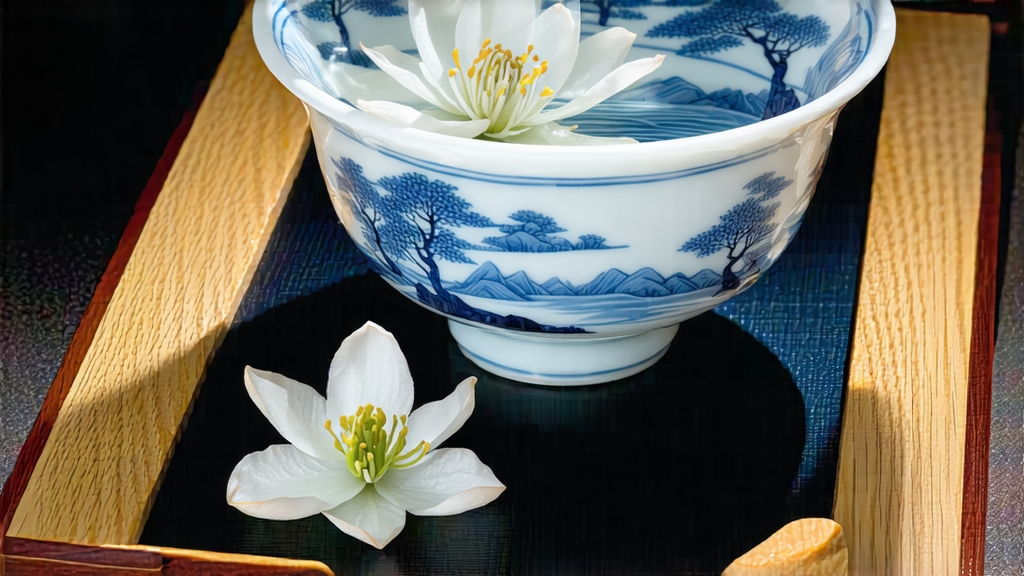
Tucked away in the mist-laced uplands of southern Yunnan, where the Mekong River bends like a dragon’s tail, a tea is picked only when the moon hangs full and low. Locals call it Yue Guang Bai—“Moonlight White”—yet it is neither a white tea in the orthodox Fujian sense, nor a pu-erh, though the same ancient tea trees feed both traditions. To understand Moonlight White is to listen to a story whispered across centuries by Dai farmers, horse-caravan tea traders, and imperial poets who believed that tea leaves, like people, dream under moonlight and remember every ray.
Historical roots
The first written reference appears in a 1648 Dai chronicle stored in Xishuangbanna’s Manfeilong Temple: “On the night of the eighth full moon, maidens pluck the downy sprout, leaving it on bamboo trays until the moon sinks; the leaf turns silver at the edges and black at the heart, a marriage of yin and yang.” Carried north by mule caravans along the Ancient Tea Horse Road, the tea became a court tribute during the early Qing, prized for its cool, nectar-sweet liquor that soothed the Manchu aristocracy’s meat-rich diet. When the caravans ceased in the 1950s, Moonlight White retreated into village memory until 2003, when a small Jingmai cooperative revived the technique to meet growing domestic demand for gentle, low-caffeine teas. Today it is the quiet star of Yunnan’s boutique white-tea renaissance, yet still harvested in volumes smaller than a single Pu-erh village’s daily output.
Cultivar and terroir
Moonlight White is fashioned almost exclusively from the Da Ye Zhong (large-leaf) Assamica variety that has evolved in Yunnan’s 1,200- to 2,000-metre elevations for over 1,700 years. The trees, many un-pruned and 5–10 metres tall, develop leaves rich in polyphenols and long-chain amino acids, giving the finished tea both heft and lingering sweetness. Soils are lateritic, laced with decomposed granite and ancient leaf mulch; rainfall arrives in convective afternoon bursts followed by cooling mountain winds—ideal for slow, even withering. Jingmai Mountain’s perennial cloud cover filters ultraviolet light, encouraging higher chlorophyll-b and carotenoid levels that translate into the tea’s signature ivory-silver fuzz and honeyed aroma.
Plucking standard
The picking window opens at dusk on the eve of the full-moon period from late March to mid-April. Only the “dragon’s tooth” pluck—two leaves and a down-covered bud—is taken, ideally from 50- to 80-year-old trees whose leaves have already weathered one dry season. Experienced pickers snap the stem with a faint click, avoiding the fingernail bruising common in green-tea harvests. Leaves are placed in shallow bamboo baskets lined with banana leaf to prevent compression and oxidation en route to the village courtyard.
Crafting moonlight
Unlike Fujian white teas that rely on sun-withering, Moonlight White is processed entirely under open-air moonlight and gentle mountain breeze. The protocol, passed down orally among Dai and Bulang families, unfolds in four hushed acts:
- Moon-withering: trays of leaves rest on raised bamboo racks from 8 p.m. until dawn. Temperature drops to 14–16 °C, humidity hovers at 70 %. The cool, diffused light oxidises catechins slowly, turning leaf edges silvery while the broader surface remains dark jade—a visual metaphor for the taijitu.
- Yin-firing: shortly after sunrise, leaves receive a 10-minute “soft bake” over a charcoal pan kept below 40 °C. The heat halts enzymatic browning yet preserves the moonlight-induced volatile esters responsible for melon and wild-flower notes.
- Shade-rest: the half-dried leaves are stacked 3 cm thick in woven rattan boxes and left in a shaded corridor for 6–8 hours. This short piling encourages microbial trans-esterification, deepening honey aroma without crossing into black-tea territory.
- Lunar drying: finally, leaves return to open-air racks for a second, longer moon-bathe lasting up to 36 hours across two nights. Moisture falls to 8–